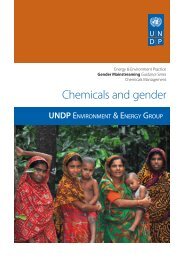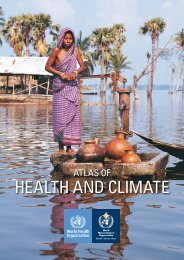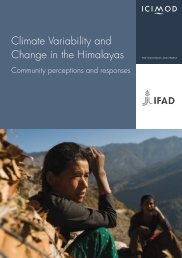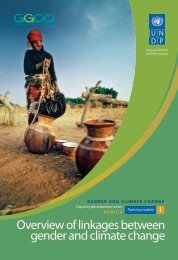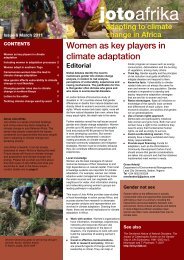Module 4: Gender, Agriculture and Food Security - Gender Climate
Module 4: Gender, Agriculture and Food Security - Gender Climate
Module 4: Gender, Agriculture and Food Security - Gender Climate
- No tags were found...
You also want an ePaper? Increase the reach of your titles
YUMPU automatically turns print PDFs into web optimized ePapers that Google loves.
5B. One main reason for this disparity is the gender gap that restricts the<br />
access of women to l<strong>and</strong>, financial services, social capital as well as access to<br />
technology, which renders them vulnerable to food insecurity (FAO 2011b;<br />
World Bank 2011a). According to a recent study by the World Bank, 103 of<br />
141 countries (25 of 35 economies in sub-Saharan Africa) have laws that likely<br />
thwart women’s economic opportunities <strong>and</strong> socio-cultural barriers that can<br />
inhibit women from effectively responding to climatic risk (World Bank 2010).<br />
See module 2 (particularly Section V) for details of social limitations imposed<br />
on the adaptive capacity of women. Often, these regressive social attitudes<br />
<strong>and</strong> traditions may be sanctioned by law (World Bank 2011b).<br />
<strong>Module</strong> No. 2<br />
6. Men also play a crucial role in food production; they, however, face fewer<br />
constraints than women. Men are more likely to have access to productive<br />
resources such as l<strong>and</strong>, credit <strong>and</strong> extension services. In cases of crop failure<br />
due to harsh climatic conditions, cultural traditions often make it easier for<br />
men to leave their farms in search of employment elsewhere, leaving women<br />
behind to struggle to feed their families <strong>and</strong> make ends meet. In many cases,<br />
women have diminished assets <strong>and</strong> resources to help them plan for <strong>and</strong><br />
potentially avert the next crisis. Related to this, it has recently been noted<br />
that numerous countries in Africa have also seen substantial increases in the<br />
female share of the agricultural labour force in recent decades due to external<br />
pressures such as conflict, HIV/AIDS <strong>and</strong> migration (FAO 2011b).<br />
Summary questions<br />
• What are the key gender issues in agriculture <strong>and</strong> food security<br />
<br />
• Give some examples of current <strong>and</strong> possible future impacts <strong>and</strong> vulnerabilities associated<br />
with climate variability <strong>and</strong> change, gender, agriculture <strong>and</strong> food security<br />
in Africa.<br />
• Why are women farmers more likely to be disproportionately vulnerable to climate<br />
change impacts than men farmers<br />
10<br />
<strong>Gender</strong> <strong>and</strong> <strong>Climate</strong> Change Capacity development series Afric a<br />
Training module 4 <strong>Gender</strong>, agriculture <strong>and</strong> food security



